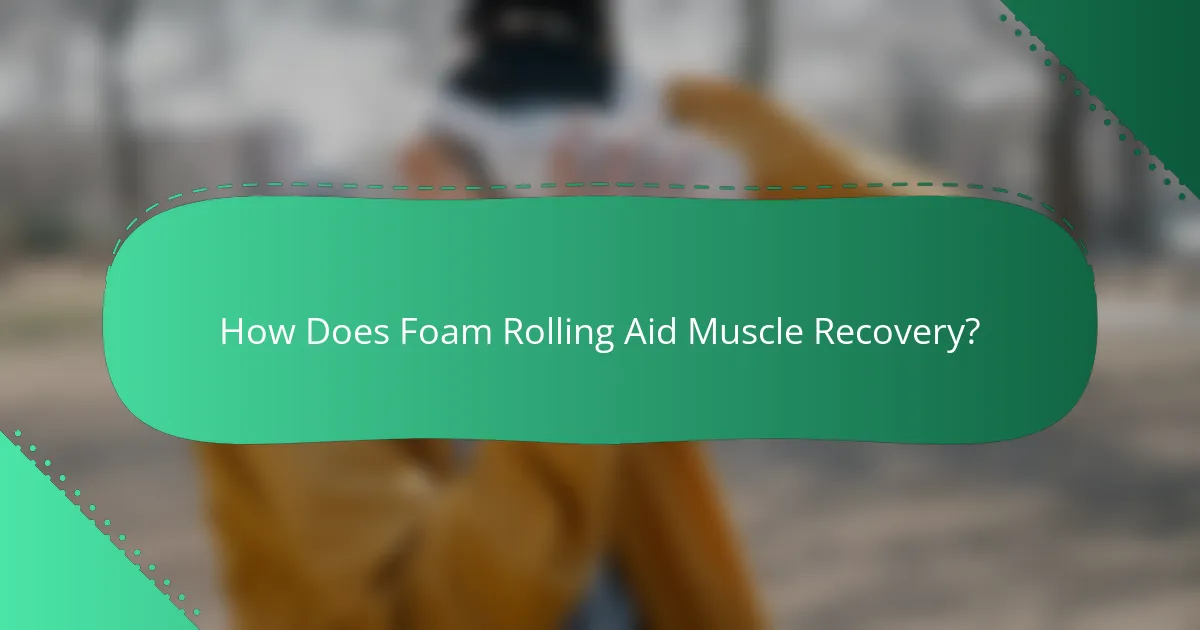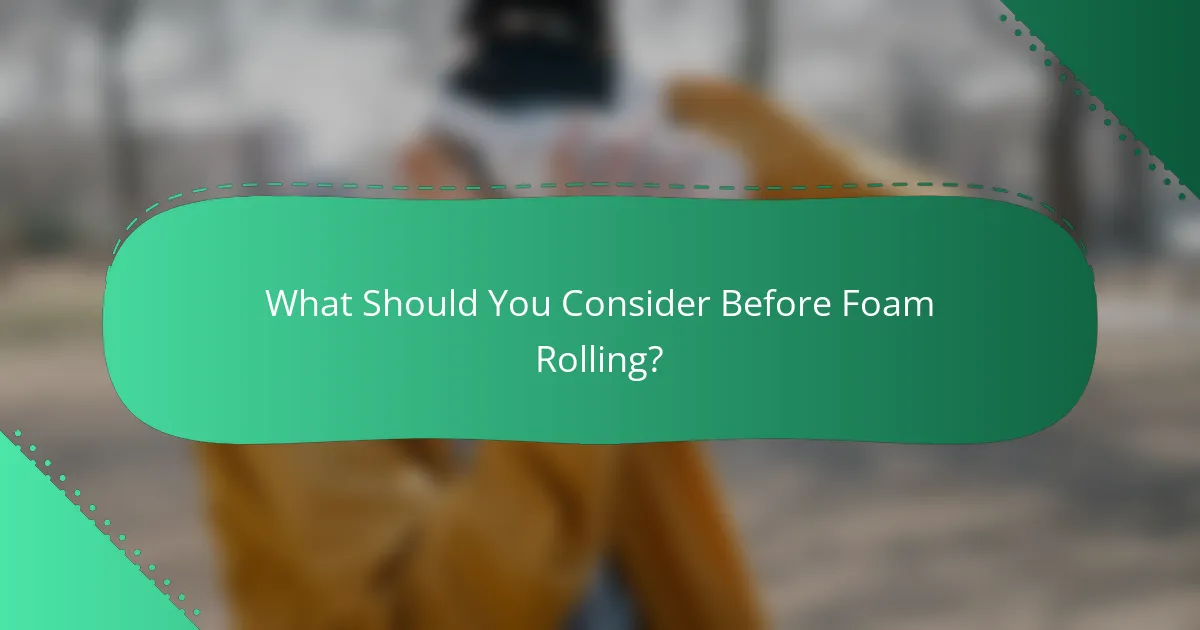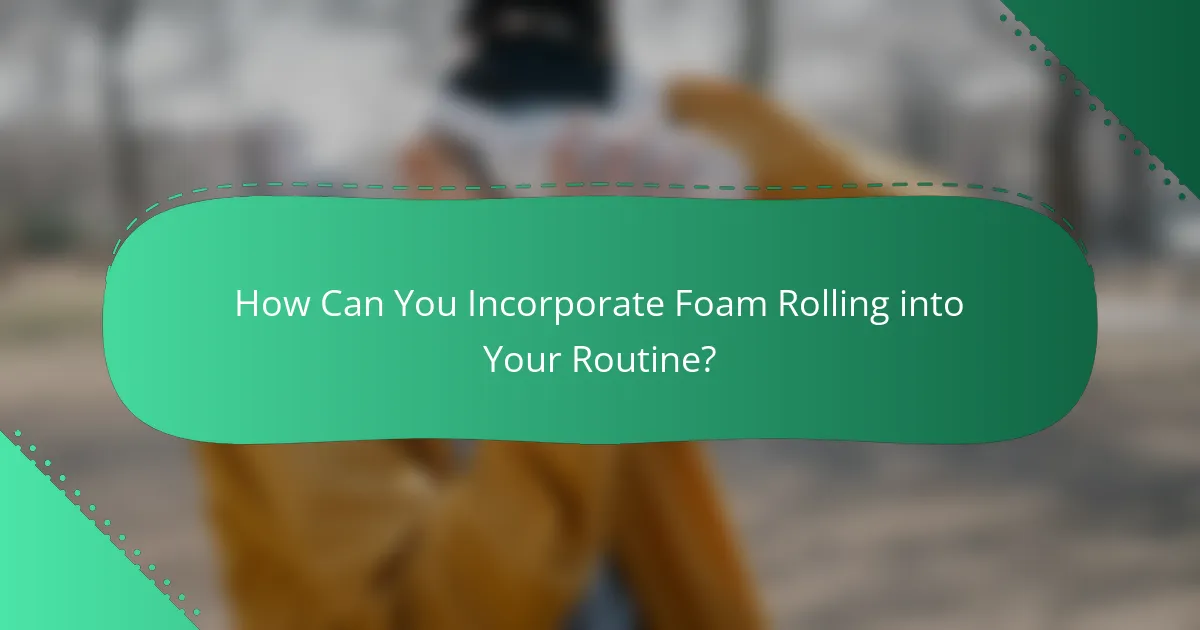Foam rolling is an effective technique for muscle recovery, offering benefits such as enhanced blood circulation, reduced soreness, and increased flexibility. By applying targeted pressure and utilizing various roller densities, individuals can alleviate muscle tension and improve their overall performance. Incorporating proper techniques can lead to significant improvements in flexibility and pain relief, making foam rolling an essential practice for athletes and fitness enthusiasts alike.

How Does Foam Rolling Aid Muscle Recovery?
Foam rolling aids muscle recovery by promoting blood circulation, reducing soreness, and improving flexibility. These benefits help athletes and fitness enthusiasts recover faster and perform better.
Increases blood flow
Foam rolling enhances blood flow to the muscles, which is crucial for recovery. Increased circulation delivers more oxygen and nutrients while removing metabolic waste products, facilitating faster healing.
To maximize blood flow, spend 1-2 minutes rolling each muscle group, focusing on areas that feel tight or sore. This technique can be particularly beneficial after intense workouts or long periods of inactivity.
Reduces muscle soreness
Foam rolling can significantly reduce delayed onset muscle soreness (DOMS), which often occurs after strenuous exercise. By applying pressure to tight muscles, foam rolling helps to break down adhesions and knots, leading to less discomfort.
For effective soreness relief, use the foam roller for 10-15 minutes post-workout, targeting each muscle group. Avoid rolling over bony areas and adjust pressure based on your comfort level to prevent injury.
Enhances range of motion
Foam rolling improves flexibility and range of motion by releasing tension in the fascia and muscles. This increased mobility can enhance athletic performance and reduce the risk of injury.
Incorporate foam rolling into your warm-up routine by spending a few minutes on major muscle groups before exercising. This practice can prepare your body for movement and improve overall performance during workouts.

What Techniques Are Effective for Pain Relief?
Effective techniques for pain relief using foam rolling focus on targeted pressure application, varying roller densities, and incorporating breathing methods. These strategies help alleviate muscle tension, enhance recovery, and improve flexibility.
Targeted pressure application
Targeted pressure application involves focusing on specific muscle groups that are tight or sore. By applying sustained pressure on these areas, you can release knots and improve blood flow, which aids in recovery. Aim to spend about 30 seconds to 2 minutes on each targeted spot, adjusting the pressure based on your comfort level.
Common areas to target include the quadriceps, hamstrings, and upper back. Use your body weight to control the intensity; for instance, shifting more weight onto the roller can increase pressure, while reducing weight can lessen it.
Using different foam roller densities
Foam rollers come in various densities, which can significantly impact pain relief. Softer rollers are generally more forgiving and suitable for beginners or sensitive areas, while firmer rollers provide deeper tissue massage and are better for experienced users. Consider starting with a softer roller and gradually progressing to a denser option as your tolerance increases.
When choosing a roller, look for options that fit your needs. For example, a high-density roller can be beneficial for targeting deep muscle layers, while a low-density roller may be ideal for general use and recovery.
Incorporating breathing techniques
Incorporating breathing techniques while foam rolling can enhance relaxation and pain relief. Deep, controlled breathing helps to reduce tension in the muscles, making it easier to release tight spots. Focus on inhaling deeply through the nose and exhaling slowly through the mouth as you roll over tight areas.
Try to synchronize your breath with your movements; for example, inhale as you prepare to apply pressure and exhale as you release it. This practice not only aids in muscle relaxation but also improves overall mindfulness during your foam rolling sessions.

Which Foam Rolling Techniques Improve Flexibility?
Foam rolling techniques that enhance flexibility primarily focus on myofascial release and muscle relaxation. By using these methods, individuals can increase their range of motion and reduce muscle tightness, leading to improved overall flexibility.
Dynamic stretching integration
Integrating dynamic stretching with foam rolling can significantly enhance flexibility. This approach involves performing active movements that stretch the muscles while using the foam roller to target tight areas beforehand. For example, rolling out the hamstrings followed by leg swings can prepare the muscles for increased flexibility.
To effectively combine these techniques, spend about 30 seconds rolling each muscle group before engaging in dynamic stretches. This method not only warms up the muscles but also helps in preventing injuries during more intense activities.
Static hold techniques
Static hold techniques involve maintaining pressure on specific muscle groups while foam rolling to release tension and improve flexibility. By holding a position for 20-30 seconds on tight areas, you allow the muscle fibers to relax and elongate. For instance, focusing on the quadriceps or calves can yield noticeable improvements in flexibility over time.
It’s essential to breathe deeply during these holds to facilitate relaxation. Avoid rolling too quickly; instead, focus on slow, controlled movements to maximize the benefits of this technique.
Specific muscle group targeting
Targeting specific muscle groups is crucial for enhancing flexibility through foam rolling. Concentrating on areas that are commonly tight, such as the hip flexors, glutes, and shoulders, can lead to significant improvements. Spend 1-2 minutes on each area, adjusting pressure based on comfort levels.
To ensure effectiveness, identify your tightest muscle groups and prioritize them in your routine. Regularly incorporating foam rolling into your flexibility training can help maintain muscle elasticity and prevent stiffness.

What Are the Best Foam Rollers Available?
The best foam rollers combine durability, texture, and size to enhance muscle recovery, pain relief, and flexibility. Selecting the right foam roller depends on your specific needs, such as muscle soreness, mobility goals, and personal preferences.
TriggerPoint GRID Foam Roller
The TriggerPoint GRID Foam Roller is designed with a unique grid pattern that mimics the hands of a massage therapist. This roller helps target knots and tight muscles effectively, making it ideal for deep tissue massage.
When using the TriggerPoint GRID, focus on rolling slowly over sore areas for 30 seconds to 2 minutes. Its compact size makes it easy to transport, making it suitable for home or gym use.
RumbleRoller Textured Foam Roller
The RumbleRoller Textured Foam Roller features a series of bumps that provide a more intense massage experience. This design is particularly beneficial for those who prefer a deeper tissue release.
To maximize its effectiveness, roll over specific muscle groups for 1-3 minutes, adjusting your body weight to control the pressure. This roller is particularly useful for athletes or individuals with chronic muscle tension.
LuxFit Foam Roller
The LuxFit Foam Roller is a versatile option that offers a smooth surface for gentle rolling or a textured surface for deeper massage. It is available in various lengths, catering to different user preferences.
For effective use, roll slowly over major muscle groups for 1-2 minutes, focusing on tight areas. This roller is budget-friendly and suitable for beginners or those looking for a straightforward recovery tool.

What Should You Consider Before Foam Rolling?
Before foam rolling, it’s essential to consider your individual health status and fitness level. These factors can significantly influence the effectiveness and safety of your foam rolling routine.
Consulting with a healthcare professional
Consulting with a healthcare professional is crucial, especially if you have existing injuries or medical conditions. A doctor or physical therapist can provide personalized advice on whether foam rolling is appropriate for you and suggest specific techniques that may be beneficial.
For those recovering from surgery or dealing with chronic pain, professional guidance can help avoid exacerbating any issues. Always prioritize safety and seek expert opinions when in doubt.
Assessing personal fitness level
Your personal fitness level plays a significant role in how you should approach foam rolling. Beginners may need to start with shorter sessions, focusing on major muscle groups, while more experienced individuals can incorporate advanced techniques and longer durations.
Consider your comfort and pain tolerance when selecting foam rolling intensity. If you’re new to the practice, aim for gentle pressure and gradually increase as your body adapts. A common recommendation is to spend about 1-2 minutes on each muscle group, adjusting based on your experience and feedback from your body.

How Can You Incorporate Foam Rolling into Your Routine?
Incorporating foam rolling into your routine can enhance muscle recovery, alleviate pain, and improve flexibility. Aim to integrate foam rolling before and after workouts, as well as on rest days, to maximize its benefits.
Pre-workout warm-up
Using foam rolling as part of your pre-workout warm-up can prepare your muscles for exercise by increasing blood flow and reducing muscle tightness. Focus on rolling major muscle groups such as the quadriceps, hamstrings, and calves for about 5-10 minutes before starting your workout.
When foam rolling pre-workout, apply moderate pressure and spend 30 seconds to 1 minute on each muscle group. This helps to release tension and improve range of motion, which can enhance your overall performance.
Be cautious not to overdo it; foam rolling should feel uncomfortable but not painful. If you experience sharp pain, reduce the pressure or skip that area to avoid injury.


